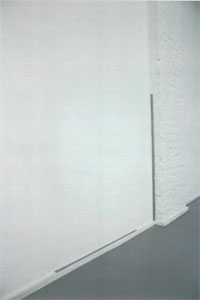
Born in 1935 in Paramaribo (SR)

1985
Aluminium bars
100 x 1,5 x 0,2 cm / 73,6 x 1,5 x 0,2 cm
Year of Purchase: 2006
A key figure among the first generation of conceptual artists, Stanley Brouwn elaborates a rigorous and discreet body of work, which complements his reserved, modest attitude. The fact that he rarely participates in his own art openings or that he turns down monograph publications devoted to his work, could be explained by a simple anecdote—if it did not signal a philosophy founded in the adequacy of a work and of a life. “Stanley Brouwn’s work has not been commented upon at the request of the artist himself who claims ‘to work with neither texts nor images’”—says one of the collection catalogues. Consequently, Brouwn’s work could be defined in its conceptual dimension as referencing a certain formal austerity. No image or text, but a relation to the world which is constantly requalified, for example through walking, and is methodically quantified, namely by a specific system of measurement.
To say that the foot, as a part of the body in constant contact with the ground, may be interpreted in Brouwn’s work as a sort of metaphor for the connection between man and universe, would probably be saying too much since this relation (just as the whole body of work) is much more multiple and complex. Nevertheless, it’s not without a certain sense of humor or without interest for this point of physical convergence that the artist decided in 1960, in a definitely post-Duchampian gesture, to make art (“faire oeuvre”) out of all the shoe stores in Amsterdam. During the same period, he also produced a series of “concrete drawings” composed of random traces made by the shoes of passers-by on large sheets of white paper.
Gradually, the trajectory and the inscription of itineraries have become essential “motifs” in his work. Thus, in 1962, Brouwn produced such programmatic works as A walk through a grass field, then A walk during one week, and A walk from a to b. The latter piece also belongs to the series This way Brouwn (1960–1964)—a set of haphazard drawings traced by passers-by whom the artist asked for directions. The entire series, as well as all his walks, explore the notion of lived space. Intervening in the street, Brouwn creates situations and recontextualizes art within the social sphere. The experimental quality and the sober character of his works, free of any stylistic devices and conventions, seem to affirm the artist’s close relation to the real.
In the early 1970s, Stanley Brouwn began materializing his relationship with the environment by undertaking a meticulous classification of his movements. Challenging traditional systems of measurement, he created standards related to parts of his body (his foot, his step, his elbow). “I have become a distance,” he said. The artist rejects the norm and contrasts it with a subjective approach to reality, thus setting the human once again at the center of an abstract structural organization.
1 × 1 foot (1998) is a square with sides the length of Brouwn’s foot. Drawn on a wall, the work also encompasses the materials of which it is comprised: bricks, concrete, plaster, and paint. If that piece evokes Lawrence Weiner’s A 36” x 36” Removal of Plaster Lathing from a Wall (1969), it nevertheless leaves behind the gesture (whether performed or not) in order to underscore the appropriation of the physical from the context. Stanley Brouwn presents here a square of the real world delimited by the inferred presence of his body.
Based on earth science, the work 1000 mm 881 mm 864 mm (1974) appears in its turn as the site of the experience of re-transcription of the metric system. By adopting an esthetic that could be qualified as administrative (metal filing cabinet, files), the piece explicitly expresses a desire for classification and conservation, while formally evoking a radical materialism. Each of the thousand files of 1000 mm 881 mm 864 mm contains the representation of a millimeter. Thus the notions of multitude and infinity are recorded here in an experience of the writing of a meter.
1m – 1step (1985) confronts the sensory (based on bodily experience) and the normative systems of measurement. Whether they’re arranged along horizontal or vertical lines in a space, or placed side by side against a wall, the aluminum bars that make up the work indicate the tension between these two systems. The first one meter-long bar is placed within sight of the second bar that reads 73.6cm. Paradoxically, it’s the absence of material that indicates a presence since the missing distance corresponds to the size of Brouwn’s foot.
Representative of conceptual exigency and its resulting radicality, Stanley Brouwn’s works acquired by FRAC Lorraine reveal the constancy and evolution of a practice decisively oriented towards the question of the experience of the real and its pure materialization.
Guillaume Mansart